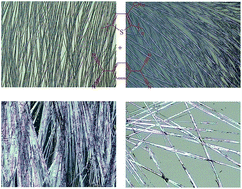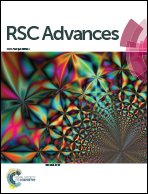Fabrication and physical properties of self-assembled ultralong polymer/small molecule hybrid microstructures†
Abstract
One-dimensional (1D) organic semiconductor micro/nano-structures (e.g. wires and tubes) have received increasing attention because these highly-ordered structures possess intriguing optical and electronic properties. Here, we reported a novel and easily-processed method to fabricate a large amount of ultralong polymer/small molecule hybrid microstructures based on classical donor poly(3-hexyl)thiophene (P3HT) and acceptor 7,7,8,8-tetracyanoquinodimethane (TCNQ). This simple solution-process via evaporating mixed solutions of P3HT/TCNQ with different ratios can generate the desired 1D microstructure with lengths of up to several centimeters. The performance of field-effect transistors based on these as-fabricated microstructures indicated that the charge-transport properties can be controlled by simply adjusting the mixture ratio, resulting in p-type, ambipolar or barely non-charge transport features. Our approach would provide a new tool to understand the growth mechanism and rational control of the ratios of appropriate materials, which is instructive to enhance the performance of organic semiconductor devices.


 Please wait while we load your content...
Please wait while we load your content...